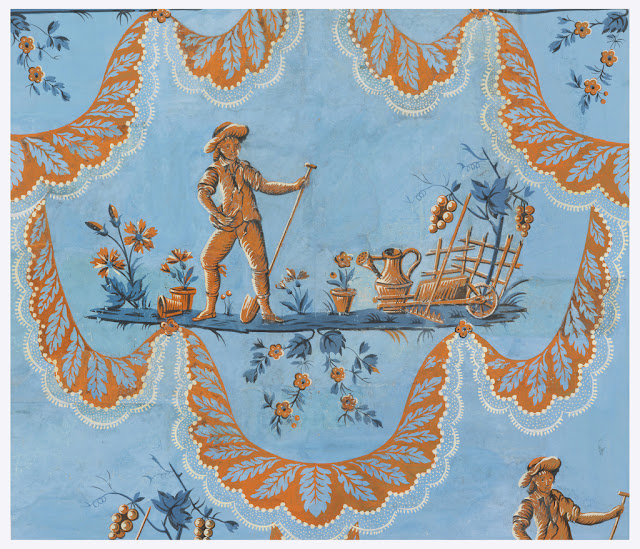 |
| Block-printed Wallpaper Frieze ca. 1800-1850 France Cooper Hewitt, Smithsonian Design Museum |
"Boredom began to be experienced in epidemic proportions during the 1840s. Lamartine is said to be the first to have given expression to this malady. It plays a role in a little story about the famous mime Deburau. A distinguished Paris neurologist was consulted one day by a patient whom he had not seen before. The patient complained of the typical illness of the times – weariness with life, deep depression, boredom. 'There's nothing wrong with you,' said the doctor after a thorough examination. 'Just try to relax – find something to entertain you. Go to see Deburau some evening, and life will look different to you.' 'Ah, dear sir,' answered the patient, 'I am Deburau.'"
– Walter Benjamin, from The Arcades Project, translated by Howard Eiland and Kevin McLaughlin (Harvard University Press, 1999)
 |
| Block-printed and Flocked Wallpaper Border ca. 1840-70 France Cooper Hewitt, Smithsonian Design Museum |
 |
| Block-printed Wallpaper ca. 1815-30 France Cooper Hewitt, Smithsonian Design Museum |
 |
| Block-printed Wallpaper with Attached Border (République française - Liberté, Égalité) ca. 1792 France Cooper Hewitt, Smithsonian Design Museum |
 |
| Block-printed Wallpaper (Unité, Indivisibilité de la République) 1792-93 Jacquemart & Bénard, France Cooper Hewitt, Smithsonian Design Museum |
"While Kracauer and Benjamin are best known for their theories of modernity based on shock and distraction, what is less known, and less remarked upon, is their central preoccupation with boredom. As Heide Schlüpmann has argued in an extremely influential essay on early German film theory: 'The relation between film and the end of bourgeois culture is not so much captured in the term distraction, in which, after all, capitalism protects itself from its loss of metaphysical elevation. It is captured rather in what are interruptions in the production process: in a boredom that protects itself against organization, in a form of leisure as waiting.'"
– Patrice Petro, from Aftershocks of the New (Rutgers University Press, 2002)
 |
| Machine-printed Wallpaper 1906-07 France Cooper Hewitt, Smithsonian Design Museum |
 |
| Block-printed and Flocked Wallpaper 1810-12 Dufour et Leroy, France Cooper Hewitt, Smithsonian Design Museum |
 |
| Block-printed Wallpaper (La Chasse au Faucon) ca. 1794-97 Jacquemart & Bénard, France Cooper Hewitt, Smithsonian Design Museum |
 |
| Block-printed Wallpaper (Overdoor Panel with Antique Arms) ca. 1784-89 France Cooper Hewitt, Smithsonian Design Museum |
 |
| Block-printed Wallpaper on a Folding Screen (Classical Statues) ca. 1800-1825 France Cooper Hewitt, Smithsonian Design Museum |
 |
| Block-printed Wallpaper (Offering to Cupid) ca. 1800 France Cooper Hewitt, Smithsonian Design Museum |
 |
| Block-printed Wallpaper ca. 1780-90 France Cooper Hewitt, Smithsonian Design Museum |
 |
| Block-printed Wallpaper (Basket-weave in grisaille) ca. 1785 Jacquemart & Bénard, France Cooper Hewitt, Smithsonian Design Museum |
"The everyday does not belong to the objective realm. To live it as what might be lived through a series of separate technical acts (represented by the vacuum cleaner, the washing machine, the refrigerator, the radio, the car), is to substitute a number of compartmentalized actions for this indefinite presence, this connected movement (which is however not a whole) by which we are continually, though in the mode of discontinuity, in relation with the indeterminate totality of human possibilities. Of course the everyday, since it cannot be assumed by a true subject (even putting in question the notion of subject), tends unendingly to weigh down into things. This anyone presents himself as the common man for whom all is appraised in terms of good sense. The everyday is then the medium in which, as Lefebvre notes, alienations, fetishisms, reifications produce their effects. He who, working, has no other life than everyday life, is also he for whom the everyday is the heaviest; but as soon as he complains of this, complains of the burden of the everyday in existence, the response comes back: 'The everyday is the same for everyone.'"
– Maurice Blanchot, from Everyday Life, translated by Susan Hanson (Yale University Press, 1987)
 |
| Block-printed Wallpaper ca. 1795-1800 France Cooper Hewitt, Smithsonian Design Museum |
 |
| Block-printed Wallpaper Frieze (Décor pastoral) 1863-65 Jules Defossé, France Cooper Hewitt, Smithsonian Design Museum |
 |
| Block-printed Wallpaper ca. 1800 France Cooper Hewitt, Smithsonian Design Museum |
 |
| Block-printed and Hand-painted Wallpaper 1788 Jean-Baptiste Réveillon, France Cooper Hewitt, Smithsonian Design Museum |
 |
| Block-printed Wallpaper ca. 1815-30 France Cooper Hewitt, Smithsonian Design Museum |
"But friendships, too, began to fray. Some evenings, within the finite fields of their unspacious rooms, the couples that had come together crossed swords by word and eye. Some evenings, they finally grasped that their fine friendships, their almost hermetic language, their private jokes, this shared world, shared language, the common gestures they had made up, were based on nothing: theirs was a shrunken universe, a world running out of steam, opening onto nothing. Their lives were not conquests, but slow collapses, dispersions. That was when they realized how deeply they were condemned to habit, to sluggishness. They were bored in each other's company as if all there had ever been between them was a void."
– Georges Perec, from Things: A Story of the Sixties, translated by David Bellos and Andrew Leak (Boston: David R. Godine, 1990)
 |
| Block-printed Wallpaper (L'Orage - Scenic Panel) 1861 Zuber & cie, France Cooper Hewitt, Smithsonian Design Museum |
 |
| Block-printed Wallpaper (Telemachus on the island of Calypso - Scenic Panel) ca. 1815-20 Xavier Mader for Joseph Dufour & cie, France Cooper Hewitt, Smithsonian Design Museum |
 |
| Block-printed and Flocked Wallpaper Borders ca. 1820-50 France Cooper Hewitt, Smithsonian Design Museum |